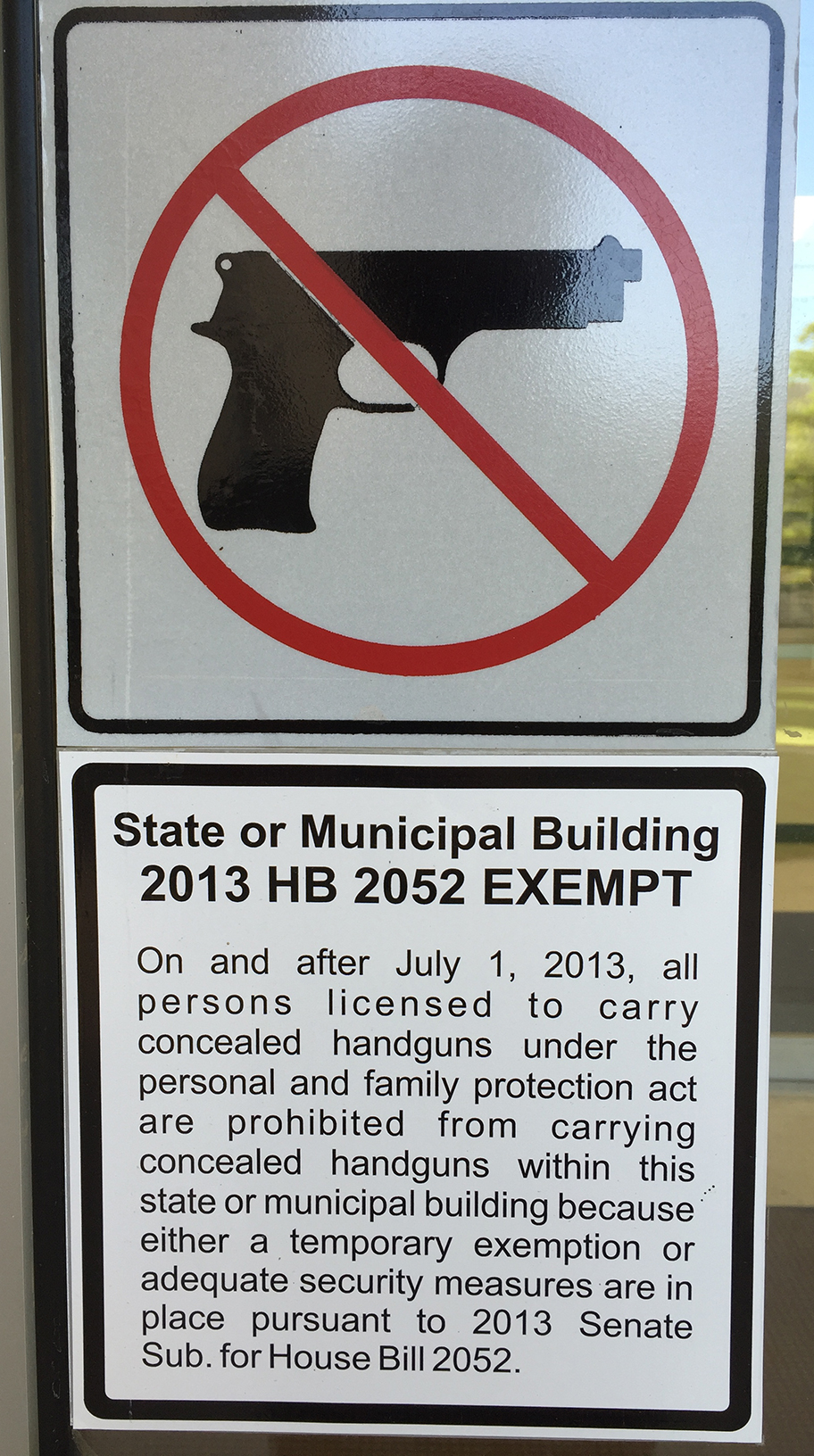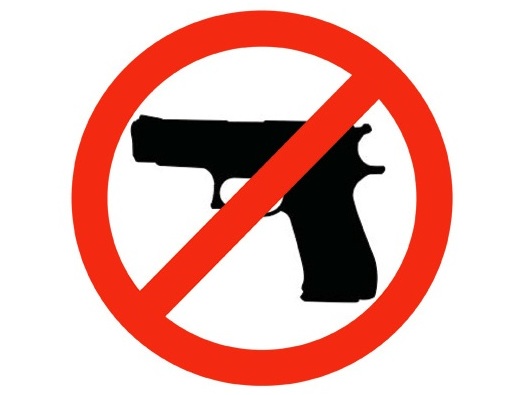As of July 1, 2017, the Kansas legislature is forcing all state universities to admit guns onto their campuses – classrooms, offices, laboratories, libraries, student unions, dormitories, counseling services. Everywhere. The Weapons Advisory Work Group has drafted a “University Weapons Policy,” and we have been invited to comment. If you’re employed by or attending Kansas State University, please submit your comments. In case you need some inspiration, here is what I wrote.
 Dear Weapons Advisory Work Group,
Dear Weapons Advisory Work Group,
Thank you for the time you’ve spent crafting the University Weapons Policy – a thankless job with an unachievable goal. Thanks also for granting us the opportunity to review the draft of this policy.
The key problem – as you likely realized, while drafting this – is the state’s (sarcastically named?) Personal and Family Protection Act is impossible to implement safely. For instance, the University Weapons Policy states, “There are no University locations that have been designated as prohibiting concealed carry with permanent adequate security measures” (p. 3). None? Not even the nuclear reactor? Or labs with volatile chemicals?
Yes, the “adequate security measures” written into the law are prohibitively expensive to implement. Those who drafted the law deliberately defined the “adequate security measures” in precisely this way. According to the law, buildings equipped with metal detectors and armed guards are the only locations where guns may be prohibited. To secure all buildings at Kansas State University (including Vet Med and the athletics buildings) would cost $110,419,000. The state of Kansas’ annual contribution to the university’s budget is approximately $160,000,000. In other words, only by devoting 69% of the state’s contribution to “adequate security measures” could the university legally secure entrances to all buildings. That’s unlikely to happen, and the legislators who voted for this bill know that.
 Perhaps the expense is why you’ve marked stadiums as an exception to the state’s campus carry policy: “To the extent adequate security measures are used to prohibit concealed carry into stadiums, arenas and other large venues that require tickets for admission, the tickets shall state that concealed carry will be prohibited at that event. Signs will be posted as appropriate” (p. 6). It’s a great idea to attempt to protect people from lethal weapons at football games. But could we not extend this language to the places where the business of the university actually gets done? If we’re willing craft such an exemption for the stadiums, then why not issue “no concealed carry” tickets for labs, classrooms, libraries, and offices?
Perhaps the expense is why you’ve marked stadiums as an exception to the state’s campus carry policy: “To the extent adequate security measures are used to prohibit concealed carry into stadiums, arenas and other large venues that require tickets for admission, the tickets shall state that concealed carry will be prohibited at that event. Signs will be posted as appropriate” (p. 6). It’s a great idea to attempt to protect people from lethal weapons at football games. But could we not extend this language to the places where the business of the university actually gets done? If we’re willing craft such an exemption for the stadiums, then why not issue “no concealed carry” tickets for labs, classrooms, libraries, and offices?
I am also puzzled as to how the university will enforce this new weapons policy. In Kansas, anyone over the age of 21 can legally conceal-carry without a permit, without training, and without a background check. As a result, the policy – while well-intentioned – does little to maintain the safety of the university’s students, faculty, and staff. For example, I appreciate the University’s attempt to provide guidelines for “Carrying and Storing Handguns” (p. 4) and for “Storage” (p. 5). But how will these guidelines be enforced? The sanctions are a start: “Any individual who violates one or more provisions of this policy may be issued a lawful directive to leave campus with the weapon immediately” (6). But what would stop the individual from coming back another day? And how will we discover that the Weapons Policy’s provisions have been violated? The individual starts shooting people? A gun goes off accidentally, and kills a classmate? Also, if there is no Campus Police officer in my classroom (and there is almost never a Campus Police officer in my classroom), what actions should I take when confronting a student or faculty member who has begun shooting people? If a shooter threatens my classroom, what might I do to minimize the carnage?
The problem here is that the law – and the University Weapons Policy it has inspired – still allows students to bring guns into classrooms, dormitories, dining facilities, counseling services, and faculty offices. It’s great to stipulate (as the university policy does) that students & faculty cannot store guns in classrooms and faculty offices, but… guns can still be brought into classrooms and faculty offices.
So, if a student has a grade dispute, am I allowed to ask if he’s armed before making an appointment to meet him in my office? Or would it be safer to just give him whatever grade he asks for? For that matter, if all of us can carry weapons, under what conditions are we allowed to fire them? If a student is acting in a way that makes an armed faculty member feel the need to defend himself or herself, when would the faculty member be justified in opening fire? The weapons policy says that when “necessary for self-defense,” one can “openly display any lawfully possessed concealed carry handgun while on campus” (p. 3). OK, but what’s the criteria for “necessary” here? If we are armed (and, for the record, I do not plan to arm myself), when would it be acceptable to shoot? Similarly, under what conditions would the shooting of a faculty member or staff member would be justified? If we’re allowing guns on campus, then guns will be used on campus. We need to establish clear criteria for their use: “necessary for self-defense” is dangerously vague.
What provisions will the university be implementing for those who are particularly at risk? For instance, a student goes to Counseling Services: she’s feeling traumatized, after being raped by a weapons enthusiast who is also a fellow student. What will the university do to ensure that she feels safe in Counseling Services, in her dorm, or in her classes? What provisions does the University Weapons Policy have for her? I would also be interested to learn how the university plans to protect those classes in which students have necessarily uncomfortable discussions about subjects that elicit strong responses: racism, genocide, sexism, transphobia. How will the University Weapons Policy ensure that classrooms are a safe space to explore difficult subjects? How will the policy address the fact that, when any classmate can potentially be carrying a weapon, we – students, teachers – are less likely to talk about challenging subjects? A university is supposed to encourage the free and open exchange of ideas, but concealed carry makes this exchange less free and less open. Where does the policy addresses this problem?
Indeed, why does the University Weapons Policy not mandate a warning on the university’s website? People (students, faculty, staff) who are both armed and untrained pose a threat to the safety of those who study and work at the university. All should be warned that entering Kansas State University’s campus after July 1, 2017 is dangerous. The university posts advisories for other hazards – thunderstorms, tornados, and the recent “boil advisory,” when a power failure compromised the town’s water supply. Why not an advisory for the increased risk of gun violence?

I understand why the weapons policy has been drafted, but it is insufficient. I realize that your mandate has been to comply with this law, even though the law itself poses a risk to the safety of all who work and study here. However, there are times when, given an absurd and dangerous task, you are morally obliged to question what you have been asked to accomplish instead of simply surrendering to its absurdity. Apply the critical thinking we teach here to the task of creating a University Weapons Policy. The university’s response to Kansas’ “Personal and Family Protection Act” should be: “No. We cannot both comply with this law and ensure the safety of our students, faculty and staff. Indeed, inviting guns onto campus is incompatible with the mission of this university. With the exception of campus security or research involving weapons, guns have no place on campus. Period.”
Sincerely yours,
Philip Nel
University Distinguished Professor
Director, Program in Children’s Literature
Department of English
Kansas State University
- Weapons Policy Amendments, including Draft university weapons policy.
- Cindy Bontrager, University weapons policy revised draft available for review, K-State Today, 24 Aug. 2016
- Kansas State University Distinguished Professors, statement on weapons policy, K-State Today, 2 Dec. 2015.
Guns in Higher Education
- American Association of University Professors, “‘Campus Carry’ Laws,” AAUP, 12 Nov. 2015
- Ian Bogost, “The armed campus in the anxiety age,” The Atlantic, 9 Mar. 2016
- Editors, “Editorial: Campus carry law needs to be repealed,” Topeka Capitol-Journal, 1 Sept. 2016.
- Editors, “The Concealed Carry Fantasy,” The New York Times, 26 Oct. 2015
- Fermin Debrabander, “How Guns Could Censor College Classrooms,” The Atlantic, 4 Mar. 2016.
- Gun-Free UT, “The Arguments Used by Campus Carry Supporters Are Wrong.” Gun-Free UT, 15 Nov. 2015.
- “Guns on Campus,” Everytown for Gun Safety, 9 July 2015
- Nate Kreuter, “Concealed in Our Classrooms,” Inside Higher Ed, 12 Apr. 2016
- Philip Nel, “Just a Shot Away,” Inside Higher Ed, 12 Apr. 2016
- Danielle S, “Campus Gun Carry Will Ruin Social Justice in the Classroom,” MamaDemics, 2 Mar. 2016
- Matt Valentine, “Texas Just Made College Less Safe,” Politico, 1 June 2015
General Resources
- Gun-Free UT (excellent site; incredible resources). Start with this debunking of arguments used by campus-carry advocates.
- Kansans Against Campus Carry.
- Stop Campus Carry. Includes a page of resources.

Mickey Ransom
Richard Baker